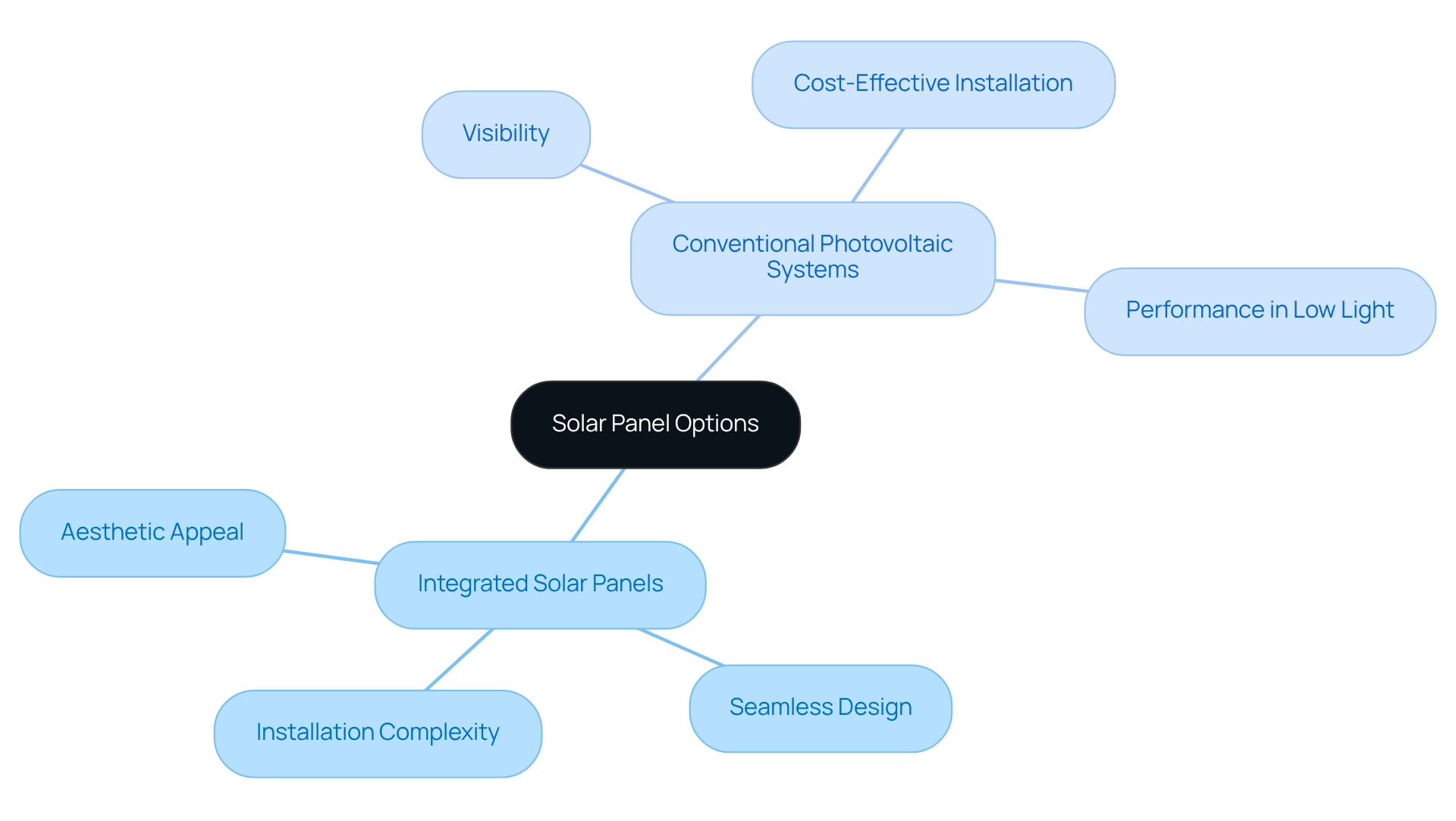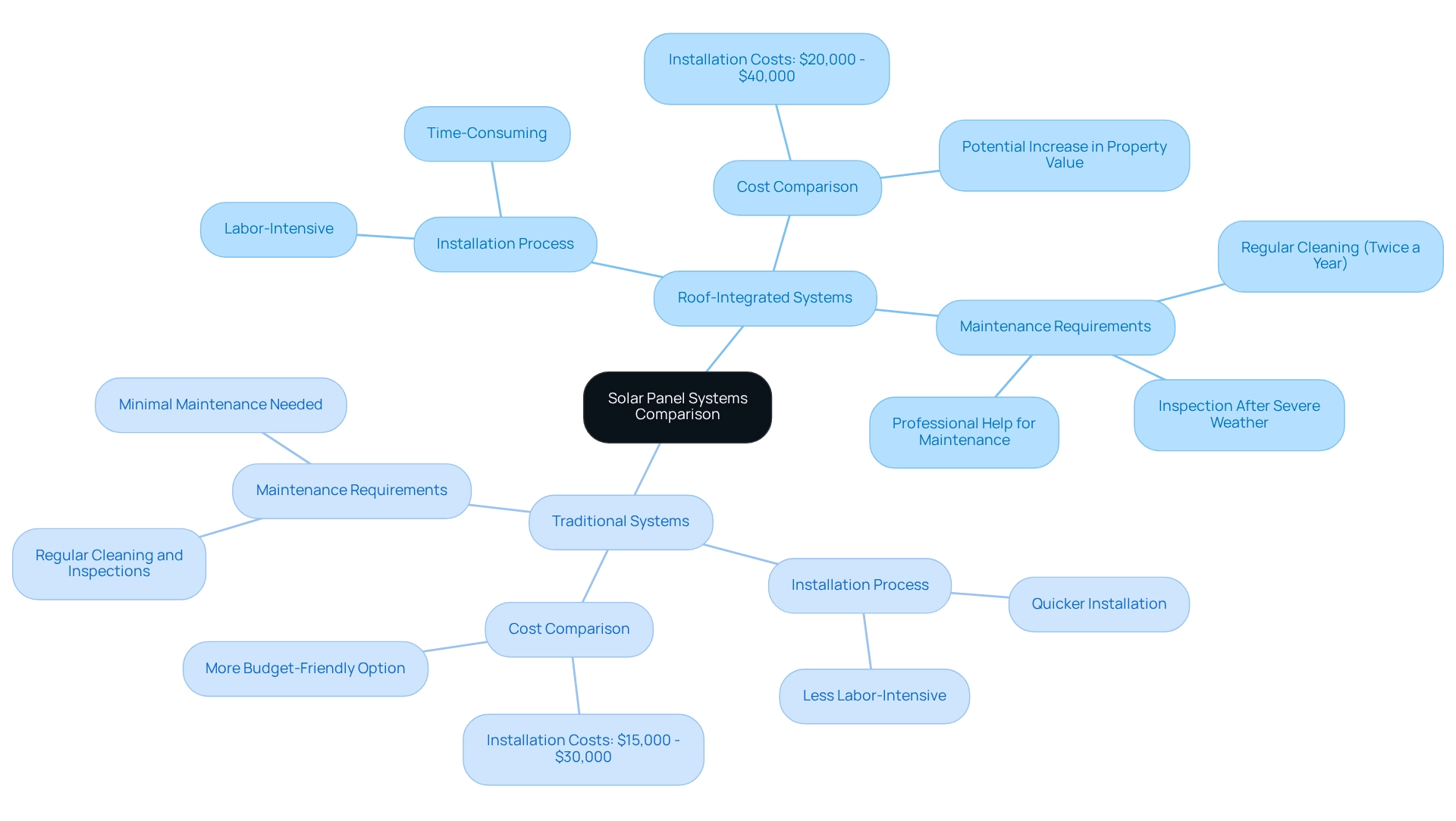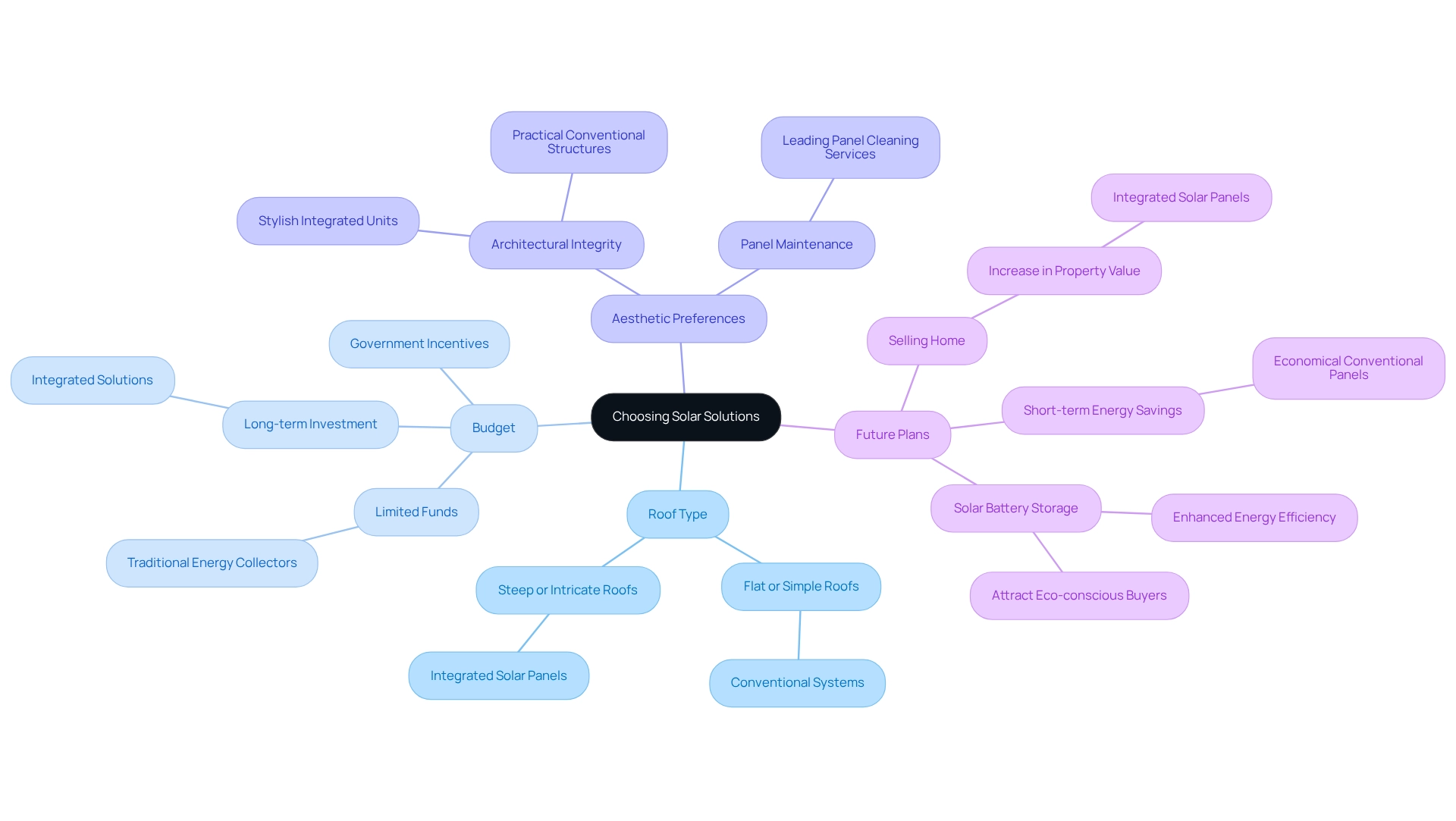Overview
We understand that many homeowners are concerned about rising energy bills. When considering solar energy, you may wonder about the options available to you. The article compares roof-integrated solar panels with traditional photovoltaic systems, shedding light on their unique advantages and disadvantages.
- Roof-integrated panels not only enhance the aesthetic appeal of your home but also save space, making them an attractive option. However, it’s important to note that they often come with higher installation costs.
- On the other hand, traditional panels are generally more affordable and easier to install, though they may detract from your home’s appearance.
By weighing these options, you can make informed decisions that align with your needs and budget. Together, let’s explore the path toward energy independence and a more sustainable future. If you have questions or need guidance, please don’t hesitate to reach out; we’re here to support you every step of the way.
Introduction
As the demand for renewable energy sources continues to rise, many homeowners find themselves grappling with the challenge of how to harness solar power effectively. We understand that the decision can feel overwhelming, especially when considering energy bills.
Two primary options present themselves:
- Roof-integrated solar panels, which seamlessly blend with your home’s architecture.
- Traditional solar panels, known for their ease of installation and cost-effectiveness.
Each choice comes with its unique set of advantages and challenges, particularly in regions like Stockton, California, where climate considerations play a crucial role in performance. Understanding the differences between these solar solutions is essential for homeowners looking to make informed decisions that align with their aesthetic preferences, budget, and energy needs. Together, we can explore these options and find the right fit for your home.
Understanding Solar Panel Integration: Roof vs. Traditional Options
As homeowners, you may often find yourselves concerned about rising energy bills and the long-term sustainability of your energy sources. When evaluating energy options from the sun, it’s important to recognize two primary varieties of photovoltaic modules: solar panels built into roof systems and conventional photovoltaic systems.
Options that incorporate solar panels built into roof designs are intended to replace conventional roofing materials, providing a seamless look while generating electricity. They tend to be less obtrusive and can enhance your home’s aesthetic appeal, providing a solution that feels both practical and beautiful, particularly with solar panels built into the roof, in contrast to conventional photovoltaic systems that are placed on top of existing roofs. While they may be more noticeable, they are generally simpler and more cost-effective to install.
For homeowners in Stockton, California, it’s essential to consider the best photovoltaic panels for those overcast days, as certain models operate more effectively under low-light conditions. Local energy firms can offer customized suggestions based on the specific climate and energy requirements of your region.
We understand that grasping these differences and local options is crucial for you as you contemplate energy solutions. It affects not just the installation process but also the overall look of your residence. Together, we can explore these options and find the best solutions to support your journey towards energy independence and sustainability.
Evaluating Pros and Cons of Roof-Integrated and Traditional Solar Panels
As you consider the options for solar energy, it’s natural to feel concerned about energy bills and the impact of your choices on your home. Let’s explore the differences between roof-integrated solar panels and traditional options, so you can make an informed decision that aligns with your needs and values.
Roof-Integrated Solar Panels:
- Pros:
- Aesthetic appeal: These panels blend seamlessly with your roof, enhancing curb appeal and creating a modern look that many buyers find attractive.
- Space-saving: By replacing traditional roofing materials, they maximize usable roof space, giving you more room for other purposes.
- Potentially higher property value: A contemporary appearance can attract buyers, making your investment worthwhile.
- Cons:
- Higher initial cost: Installation can be more expensive due to the complexity of integrating them with your roofing, which may raise concerns about your budget.
- Limited availability: There are fewer manufacturers and options compared to traditional panels, which can feel limiting when making your choice.
Traditional Solar Panels:
- Pros:
- Lower installation costs: Generally, they are easier and quicker to install, which can ease the burden on your finances.
- Greater variety: You’ll find more options available in terms of size, efficiency, and price, allowing you to select what best suits your needs.
- Proven technology: With established performance metrics and reliability, you can feel confident in your choice.
- Cons:
- Aesthetic concerns: Traditional panels can be bulky and may detract from your home’s appearance, which is a common worry for many homeowners.
- Potential roof damage: Their installation may require additional structural support, risking your roof’s integrity, and it’s understandable to be cautious about that.
We understand that making the right choice for your home is crucial. By weighing these pros and cons, you can find a solution that not only meets your energy needs but also aligns with your values. Together, we can navigate this journey towards energy independence and sustainability, ensuring you feel supported every step of the way.
Comparing Installation, Costs, and Maintenance Requirements
We understand that navigating the world of energy solutions can feel overwhelming, especially when considering the installation process for solar panels built into roof systems. This often involves replacing existing roofing materials, which can be more labor-intensive and time-consuming than the installation of conventional systems. This complexity can lead to higher labor costs, which may raise concerns for many homeowners. On the other hand, conventional photovoltaic systems are installed atop the existing roof, resulting in a quicker and typically more affordable installation.
Cost Comparison:
- Roof-Integrated Photovoltaic Systems: Installation expenses can vary from $20,000 to $40,000, depending on the size and intricacy of the roof. This higher cost reflects the integration of solar panels built into the roof structure, which not only enhances aesthetics but can also potentially increase property value.
- Traditional Solar Panels: Costs generally range from $15,000 to $30,000 for a similar capacity system, making them a more budget-friendly option for many homeowners seeking to reduce their energy bills.
Maintenance Requirements:
Both systems require minimal maintenance, primarily involving periodic cleaning and inspections to ensure optimal energy production. Here are some tips to help you maintain your photovoltaic systems effectively:
- Regular Cleaning: Clean the surfaces at least twice a year to remove dust, debris, and bird droppings that can block sunlight.
- Inspection: Conduct regular inspections for any signs of damage or wear, especially after severe weather.
- Professional Help: If you’re uncomfortable with heights or lack the necessary equipment, consider hiring a professional for maintenance.
However, it’s important to note that integrated systems may necessitate more careful handling during roof repairs or replacements, as they are part of the roofing structure. Regular cleaning is essential for maintaining efficiency and maximizing energy output, particularly in areas where dust or debris tends to accumulate. Together, we can ensure that your investment in solar energy remains a source of pride and efficiency for years to come.
Determining Suitability: Which Solar Solution Fits Your Home?
Choosing between integrated roofing systems and conventional energy solutions can be a significant decision, and it’s natural to have various considerations in mind:
- Roof Type: If your home features a steep or intricate roof design, solar panels built into the roof may offer both visual appeal and effectiveness. For flat or straightforward roofs, conventional systems might be a more suitable choice.
- Budget: We understand that budget constraints are a common concern. Homeowners with limited funds might lean towards traditional energy collectors due to their lower initial costs. However, if you’re looking for a long-term investment that enhances your home’s beauty, integrated solutions could be worth the higher upfront expense. Additionally, government initiatives may provide financial incentives that make renewable energy systems more accessible.
- Aesthetic Preferences: Preserving your home’s architectural integrity is important, and integrated units can provide a stylish, contemporary look. While conventional structures are practical, they can sometimes detract from your home’s charm. The availability of leading panel cleaning services can also help maintain the appearance of conventional panels, should you choose that route.
- Future Plans: If you’re considering selling your home in the near future, you may want to think about the potential increase in property value that solar panels built into the roof can bring. Conversely, if short-term energy savings are your focus, economical conventional panels might be more appealing. Furthermore, exploring options like solar battery storage can enhance energy efficiency and attract eco-conscious buyers.
Ultimately, this decision is about what feels right for you and your home. Together, we can explore the best options that align with your values and aspirations for energy independence.
Conclusion
Choosing between roof-integrated and traditional solar panels is an important decision for homeowners who wish to take advantage of solar energy. We understand that aesthetics and property value are significant concerns, and roof-integrated panels provide a seamless look that can enhance your home’s appeal. However, it’s also essential to consider the higher installation costs and limited availability that may come with this option.
On the other hand, traditional solar panels offer a more budget-friendly choice with proven technology and a variety of options. While they might not blend as harmoniously with your home, their ease of installation and lower upfront costs make them a practical solution for many families. Ultimately, the best choice will depend on your personal preferences, budget, and the unique characteristics of your home.
By thoughtfully weighing the pros and cons of each option and considering factors like roof type and your future plans, you can make informed decisions that align with your energy needs and aesthetic desires. Embracing solar energy not only supports sustainability but also positions you to enjoy long-term savings and increased property value in a world that increasingly values renewable energy solutions. Together, let’s explore how we can support your journey towards energy independence and a brighter, more sustainable future.






